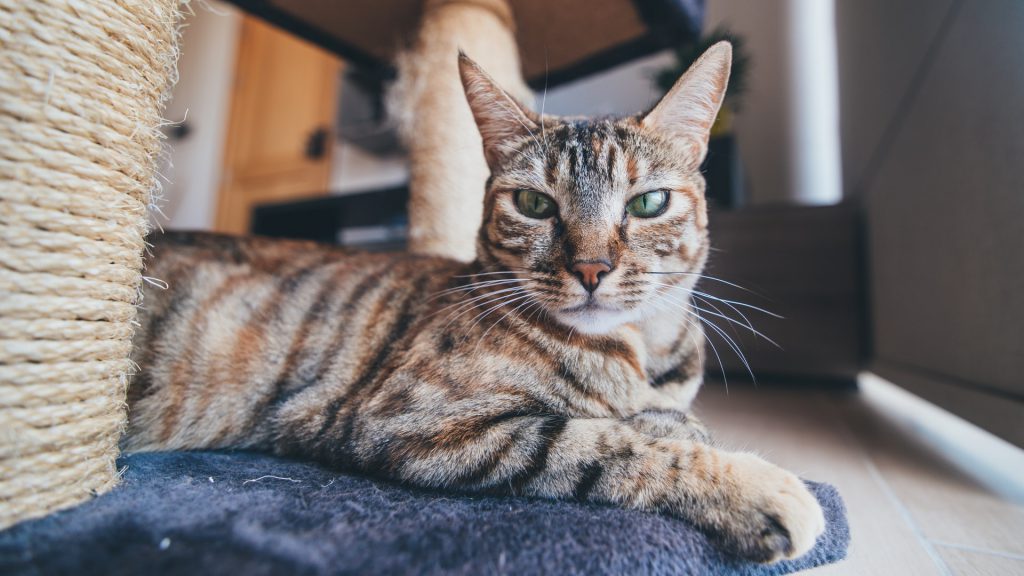So, you have decided to adopt a new cat? Making space for a new family member is a very exciting time.
No doubt you have a lovely idea about how this relationship will work out. There will be lap sits and cuddles, there will be playful antics and there will be laughter and love. You have it all figured out and the moment to bring your chosen friend home is soon upon you.
Whether this is your first cat, or another in a long list of feline companions you have had over the years, the following tips written by Animal Aid foster carer Miss Fluffy, can show you how to prepare your home to welcome a new cat, help you out with running the daily household chores that come with maintaining your feline friend.
Before arrival of your New Cat
In the days leading up to welcoming your adopted cat there are key ingredients to be gathered to help prepare your home for your new cat.
The big ticket items are – bowl for water, bowl/plate for food, mat for food bowls (if you are fussy about your floors getting wet and or little dried bits of cat food stuck to them, I just find it practical when it comes to cleaning to have this and means I can have the food and water in a carpeted room if need be), litter box, collar (if you choose) and a bedding situation plan (this can be as simple as a towel wrapped in some polar fleece. The key with these items is to make sure they are easily washable.
Don’t go too crazy on equipment initially. Give yourself some room to learn about your new friends interests and personality before you go out and end up getting something that may never be used.
Also consider your current home environment and if there are dangers that may pose a threat to your cat. A quick declutter and house clean is a great idea to help in preparing your home. Keep in mind that some plants can be toxic to cats, and with their curious nature cats can get into cupboards, tight spaces and even find a way out of your home altogether! With a little forethought you can pre-empt any escape attempts or expensive vet visits.
Some words of advice
Depending on where your cat is coming from there may be information you can gather ahead of time on what your cats preferences are.
If you are adopting from a shelter you will be advised on what food the cat is currently eating and any other requirements or habits your new friend has. Particularly with cats a few years old where their habits may be formed and this information will save you going through many alternatives (read many trips to the supermarket and buying one of every kind of cat food to discover they actually like raw meat!) before finding what will welcome your cat best.
Dealing with litter
An inevitable part of having a new cat is dealing with, well what comes out. I could write a whole article on litter, but this one by The Zero Waste Pet covers it perfectly. This is one of the single biggest causes for upsets in the house – both yours and your pets.
Depending on where you have decided for your litter to go an enclosed litter can be a suitable arrangement. This will minimise litter and other substances outside of the box, particularly if your new friend is a ‘digging to the centre of the earth’ kind of litter user.
It is recommended to get compostable bags. These are currently the best solution for dealing with your litter and being kind to the environment. And yes, this is a daily chore, no ifs ands or buts otherwise you may find your cat finding alternative locations around the house if the litter box is not kept up to standard.
Lastly, the smells. To eradicate smells use a pet friendly odour eater like Trouble and Trix NO MORE Litterbox Odours. A few sprays after scooping out the solids each day can keep the majority of your litter fresh between the weekly full clean outs.
Oh the toys
Many people who have had the joys of watching internet cat videos will recall at some stage seeing a cat in a box. Honestly, this is the best cat amusement centre available to humankind.
Oh but there is a super cute and very colour coordinated cat house on Amazon, and everyone is going crazy over the flappy fish and all the hessian wrapped catnip laced goodies that if I buy it will mean my cat will love me that little bit more!
Go ahead, be prepared to sink hundreds of dollars to come to the conclusion – the cat is happy in a cardboard box, neigh prefers the cardboard box. You can jazz up your cardboard box with some paw sized holes and using some household materials you will have hours of playtime ahead.
On arrival
Have a safe space prepared. This can be a spare room or your bedroom. Somewhere that is enclosed and has all the cats things that you have prepared. Your new cat should spend 3-4 hours in this space getting acquainted with their ‘things’, smells and the noises that are in your home.
Spend some time in and out of the room initially playing and getting to know each other. Speak to your cat with a reassuring tone and begin to familiarise with your voice and their name you have chosen.
When the cat has found a spot to sit and relax and appears comfortable, leave the door open and let your cat explore the next space themselves. If there is something scary or unexpected the cat will return to its safe space and be able to reassure themselves until ready to embark again on exploring their new home.
Whatever you do, don’t do this
Cats are pretty resilient, and can withstand most calamities (sometimes being the cause of them) but a few things when bringing your cat home for the first time can ensure that the friendship lasts.
Leave outside exploration for a few weeks. At least two weeks of indoor time means the cat will have a better chance of coming back to you if they wander.
Do not use your cat’s name as a punishment. If there is a behaviour you want to encourage and another to discourage consider how you can offer or facilitate the cat to follow this rule. A classic example is scratching furniture. If you find that the cat is scratching in unwanted areas, use cardboard scratchers or make your own using a tree stump and sisal rope and put them in desirable places. Attract your cat by praise and play for doing the right thing. This has a longer lasting effect on a cat’s neural pathways than punishment actions.
Best wishes and happy memories
Don’t forget to contact your local council and find out what the requirements are for pet ownership in your area.
There are many cats in need of forever homes in our shelters. When it comes time for you to take on the responsibility of adopting a cat, please choose shelter animals like those at Animal Aid who need loving forever homes.


